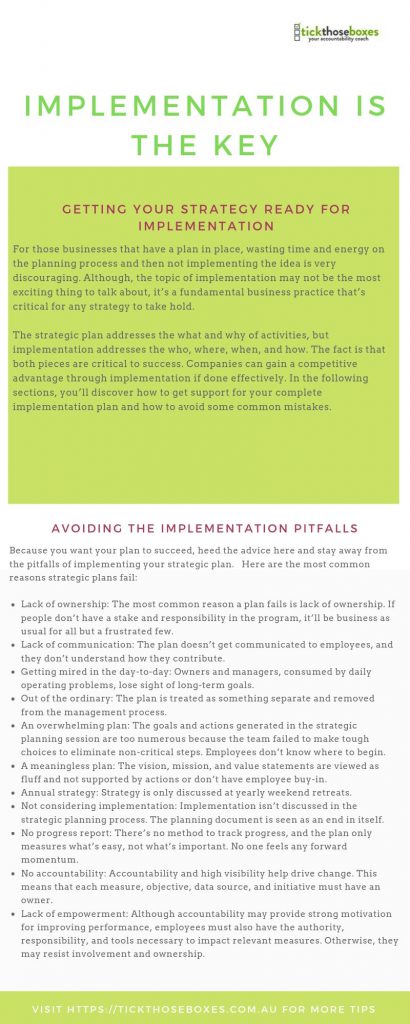
Accountability for Business Owners
Learn how accountability can help business owners build more sustainable
The Accountability Guy®

Implementation is the process that turns strategies and plans into actions to accomplish strategic objectives and goals. Implementing your strategic plan is vital and is as essential, or even more important, than your strategy.
Critical actions move a strategic plan from a document that sits on the shelf to activities that drive business growth. Sadly, the majority of companies who have strategic plans fail to implement them.
According to Fortune Magazine, nine out of ten organizations fail to achieve their strategic plan for many reasons:
A strategic plan provides a business with the roadmap it needs to pursue a specific strategic direction and set of performance goals, deliver customer value, and be successful. However, this is just a plan; it doesn’t guarantee that the desired performance is reached any more than having a roadmap guarantees the traveller arrives at the desired destination. Interestingly, a goal without a plan, I call nothing more than a wish.
Getting Your Strategy Ready for Implementation
For those businesses that have a plan in place, wasting time and energy on the planning process and then not implementing the idea is very discouraging. Although the topic of implementation may not be the most exciting thing to talk about, it’s a fundamental business practice that’s critical for any strategy to take hold.
The strategic plan addresses the what and why of activities, but implementation addresses the who, where, when, and how. The fact is that both pieces are critical to success. Companies can gain a competitive advantage through implementation if done effectively. In the following sections, you’ll discover how to get support for your complete implementation plan and how to avoid some common mistakes.
Avoiding the Implementation Pitfalls
Because you want your plan to succeed, heed the advice here and stay away from the pitfalls of implementing your strategic plan.
Here are the most common reasons strategic plans fail:
It’s easier to avoid pitfalls when they’re identified. Now that you know what they are, you’re more likely to jump right over them!

DELIVERING WHAT YOU PROMISE
and getting your team to do the same
Do you meet the obligations, promises, goals and commitments made to yourself and to others?
The American Society of Training and Development (ASTD) did a study in 2010 on accountability and found out that the probability of completing a goal is:
After reading this, how likely are you to achieve your; goals, promises, obligations and commitments alone?
Book your FREE Unboxing Session with me ‘The Accountability Guy’ and we’ll examine exactly where you’re at, what’s worked and what hasn’t, and we’ll take a look at your priorities to set the path moving forward. Each Unboxing Session includes:
For more information visit: call me directly: +61 418-379 369.

Darren Finkelstein, The Accountability Guy®, is the founder of TICK THOSE BOXES, a specialised accountability coaching practice. Darren is a formidable international accountability coach, business advisor, mentor, and author/speaker, fostering development and measurable results in entrepreneurship, leadership, and accountability. Darren’s tale is one of perseverance, self-reinvention, and resilience.
With compelling execution, Darren has empowered high-achieving individuals and teams from Australia and New Zealand to Latin America, Europe, Asia, the UK, and the US to embrace accountability; after all, it is your superpower.
Darren’s one-on-one and group coaching programs are based on his bestselling business book, “The Accountability Advantage – Play your best game” and the latest, release “NO’ – Building a life of choice without obligation”.
Darren has an impressive background in business, having held the role of “Manager of Commercial Markets” at Apple Australia during the Steve Jobs revolution.
He enthusiastically “walks the talk,” having also successfully sold and exited his lifestyle businesses, which served as the impetus for establishing his coaching and mentoring business.
Join Darren on this transformative quest to accomplish the remarkable.
Read Darren’s full bio here:
https://tickthoseboxes.com.au/about/

Know what to do first

know what to do next

know what to do more of

Learn how accountability can help business owners build more sustainable

Boost productivity and trust within your team. Unveil the power

Learn about Positive Accountability, see what it is, why you

Accountability drives success in so many ways. Whenever I coach

Are You Responsible or Accountable? The underlying principles undoubtedly apply

Discover why accountability is crucial for effective leadership. Learn how
Navigation
Learn More
Contact
Social Media
Copyright Darren Finkelstein 2022 | Privacy Policy | Terms and Conditions